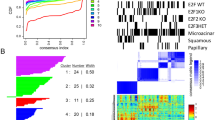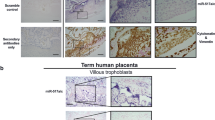Abstract
The product of the nm23 gene has been proposed as a candidate tumour metastasis suppressor protein. A strong association has been observed between reduced expression of the nm23 gene and acquisition of metastatic behaviour in some tumour cells, including breast cancer and melanoma, but not in others, such as neuroblastoma and colon, cervical and thyroid cancers. During the early gestation period both human and murine trophoblast cells exhibit in vitro invasive properties similar to those of neoplastic cells. Such invasive properties, however, disappear in the late stage of gestation. In the present study, we examined the abundance of nm23 mRNA from various fetal-maternal interface tissues (uterus, decidua, placenta and embryo) during early (day 8), mid (day 14) and late (day 18) stages of gestation in CD1 mice, in order to determine whether nm23 plays any anti-invasive and/or biological roles during gestation. nm23 was found to be expressed in all the tissues during the early and mid stages of gestation. The expression levels were, however, variable among different tissues and development stages. In the early stage, nm23 mRNA levels were the highest and similar among tissues from the uterus, decidua, placenta and embryo. In the mid stage, the mRNA levels were reduced significantly in the uterus, decidua and placenta, but not in the embryo. In the late stage, nm23 mRNA was further reduced to the extent that it could not be seen in the decidua, was barely seen in the uterus and was weakly present in the placenta. However, the mRNA level of the embryo in the late stage was still high and similar to the early stage. We also examined nm23 expression in trophoblast cells from normal human term placenta and a highly metastatic human choriocarcinoma cell line, JAR. nm23 expression was significantly higher in JAR than in normal placenta, indicating that nm23 does not appear to have an anti-metastatic function in this cell line. Several cytokines--interleukin 2 (IL-2), tumour necrosis factor alpha (TNF-alpha) and interferon gamma (IFN-gamma)--and prostaglandin E2 (PGE2) known to modulate tumour growth and metastasis were examined to determine whether they regulate nm23 expression in JAR in vitro. The B16F10 melanoma cell line was used as control. No effect was found in the JAR cell line, whereas TNF-alpha, IFN-gamma and PGE2 down-regulated nm23 expression in the B16F10 cell line.(ABSTRACT TRUNCATED AT 400 WORDS)
This is a preview of subscription content, access via your institution
Access options
Subscribe to this journal
Receive 24 print issues and online access
$259.00 per year
only $10.79 per issue
Buy this article
- Purchase on Springer Link
- Instant access to full article PDF
Prices may be subject to local taxes which are calculated during checkout
Similar content being viewed by others

Author information
Authors and Affiliations
Rights and permissions
About this article
Cite this article
Shi, Y., Parhar, R., Zou, M. et al. Differential nm23 gene expression at the fetal–maternal interface. Br J Cancer 70, 440–444 (1994). https://doi.org/10.1038/bjc.1994.324
Issue Date:
DOI: https://doi.org/10.1038/bjc.1994.324
This article is cited by
-
Cancer metastasis: enactment of the script for human reproductive drama
Cancer Cell International (2017)
-
The mystery of nm23H1 in thyroid cancer
Journal of Endocrinological Investigation (2002)


